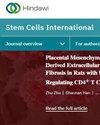Human Umbilical Mesenchymal Stem Cells-Derived Microvesicles Attenuate Formation of Hypertrophic Scar through Multiple Mechanisms
IF 3.3
3区 医学
Q2 CELL & TISSUE ENGINEERING
引用次数: 0
Abstract
Mesenchymal stem cells and the derived extracellular microvesicles are potential promising therapy for many disease conditions, including wound healing. Since current therapeutic approaches do not satisfactorily attenuate or ameliorate formation of hypertrophic scars, it is necessary to develop novel drugs to achieve better outcomes. In this study, we investigated the effects and the underlying mechanisms of human umbilical mesenchymal stem cells (HUMSCs)-derived microvesicles (HUMSCs-MVs) on hypertrophic scar formation using a rabbit ear model and a human foreskin fibroblasts (HFF) culture model. The results showed that HUMSCs-MVs reduced formation of hypertrophic scar tissues in the rabbit model based on appearance observation, and hematoxylin and eosin (H&E), Masson, and immunohistochemical stainings. HUMSCs-MVs inhibited invasion of HFF cells and decreased the levels of the α-SMA, N-WASP, and cortacin proteins. HUMSCs-MVs also inhibited cell proliferation of HFF cells. The MMP-1, MMP-3, and TIMP-3 mRNA levels were significantly increased, and the TIMP-4 mRNA level and the NF-kB p65/β-catenin protein levels were significantly decreased in HFF cells after HUMSCs-MVs treatment. The p-SMAD2/3 levels and the ratios of p-SMAD2/3/SMAD2/3 were significantly decreased in both the wound healing tissues and HFF cells after HUMSCs-MVs treatment. CD34 levels were significantly decreased in both wound healing scar tissues and HFF cells after HUMSCs-MVs treatment. The VEGF-A level was also significantly decreased in HFF cells after HUMSCs-MVs treatment. The magnitudes of changes in these markers by HUMSCs-MVs were mostly higher than those by dexamethasone. These results suggested that HUMSCs-MVs attenuated formation of hypertrophic scar during wound healing through inhibiting proliferation and invasion of fibrotic cells, inflammation and oxidative stress, Smad2/3 activation, and angiogenesis. HUMSCs-MVs is a potential promising drug to attenuate formation of hypertrophic scar during wound healing.人脐间充质干细胞衍生的微泡通过多种机制减轻增生性瘢痕的形成
间充质干细胞及其衍生的细胞外微泡是许多疾病的潜在治疗方法,包括伤口愈合。由于目前的治疗方法不能令人满意地减轻或改善增生性疤痕的形成,有必要开发新的药物来达到更好的效果。在这项研究中,我们通过兔耳模型和人包皮成纤维细胞(HFF)培养模型研究了人脐间充质干细胞(HUMSCs)来源的微泡(HUMSCs- mv)对增生性瘢痕形成的影响及其潜在机制。外观观察、苏木精和伊红(H&E)、Masson和免疫组化染色结果显示,humscs - mv减少了兔模型增生性瘢痕组织的形成。humscs - mv抑制HFF细胞的侵袭,降低α-SMA、N-WASP和cortacin蛋白的水平。HUMSCs-MVs还能抑制HFF细胞的增殖。humscs - mv处理HFF细胞后,MMP-1、MMP-3和TIMP-3 mRNA水平显著升高,TIMP-4 mRNA水平和NF-kB p65/β-catenin蛋白水平显著降低。humscs - mv处理后,伤口愈合组织和HFF细胞中p-SMAD2/3水平和p-SMAD2/3/ 3比值均显著降低。humscs - mv处理后,伤口愈合瘢痕组织和HFF细胞中的CD34水平均显著降低。humscs - mv处理后,HFF细胞中VEGF-A水平也显著降低。这些指标的变化幅度大多高于地塞米松。这些结果表明,humscs - mv通过抑制纤维化细胞的增殖和侵袭、炎症和氧化应激、Smad2/3的激活和血管生成,减轻了创面愈合过程中增生性瘢痕的形成。humscs - mv是一种潜在的有前景的药物,可以减轻创面愈合过程中增生性瘢痕的形成。
本文章由计算机程序翻译,如有差异,请以英文原文为准。
求助全文
约1分钟内获得全文
求助全文
来源期刊

Stem Cells International
CELL & TISSUE ENGINEERING-
CiteScore
8.10
自引率
2.30%
发文量
188
审稿时长
18 weeks
期刊介绍:
Stem Cells International is a peer-reviewed, Open Access journal that publishes original research articles, review articles, and clinical studies in all areas of stem cell biology and applications. The journal will consider basic, translational, and clinical research, including animal models and clinical trials.
Topics covered include, but are not limited to: embryonic stem cells; induced pluripotent stem cells; tissue-specific stem cells; stem cell differentiation; genetics and epigenetics; cancer stem cells; stem cell technologies; ethical, legal, and social issues.
 求助内容:
求助内容: 应助结果提醒方式:
应助结果提醒方式:


